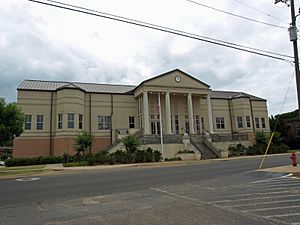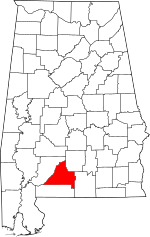Conecuh County, Alabama facts for kids
Quick facts for kids
Conecuh County
|
||
|---|---|---|

The Conecuh County Government Center in Evergreen
|
||
|
||

Location within the U.S. state of Alabama
|
||
 Alabama's location within the U.S. |
||
| Country | ||
| State | ||
| Founded | February 13, 1818 | |
| Seat | Evergreen | |
| Largest city | Evergreen | |
| Area | ||
| • Total | 853 sq mi (2,210 km2) | |
| • Land | 850 sq mi (2,200 km2) | |
| • Water | 2.6 sq mi (7 km2) 0.3% | |
| Population
(2020)
|
||
| • Total | 11,597 | |
| • Estimate
(2023)
|
11,174 |
|
| • Density | 13.596/sq mi (5.249/km2) | |
| Time zone | UTC−6 (Central) | |
| • Summer (DST) | UTC−5 (CDT) | |
| Congressional district | 2nd | |
|
||
Conecuh County is a county in the south-central part of Alabama. As of 2020, about 11,597 people live there. Its main town, or county seat, is Evergreen. The name "Conecuh" is thought to come from a Creek Indian word meaning "land of cane."
Contents
History of Conecuh County
For thousands of years, different groups of Native Americans lived along the rivers in this area. French and Spanish explorers later met the Creek Indians. British traders also became friends with the Creek people. Some British traders even married important Creek women. In the Creek culture, children belonged to their mother's family group, called a clan, and got their social standing from her.
During the American Revolutionary War, a leader of the Upper Creek tribe named Alexander McGillivray worked with the British. He hoped the British would help stop American colonists from taking Creek land.
Conecuh County was officially created by Alabama on February 13, 1818. Later, in 1868, some of its land was used to create Escambia County. In the 1800s, Conecuh County had many large farms called plantations. They grew a lot of cotton. Even today, the county is mostly rural, meaning it has a lot of open land and small towns. In the 1940s, many African American residents moved away to bigger cities in the North during a time called the Great Migration.
In September 1979, Hurricane Frederic caused a lot of damage, and the county was declared a disaster area.
Geography of Conecuh County
Conecuh County covers about 853 square miles. Most of this is land, with only a small part being water.
Main Roads in Conecuh County
 Interstate 65
Interstate 65 U.S. Highway 31
U.S. Highway 31 U.S. Highway 84
U.S. Highway 84 State Route 41
State Route 41 State Route 83
State Route 83
Neighboring Counties
- Butler County (to the northeast)
- Covington County (to the southeast)
- Escambia County (to the south)
- Monroe County (to the northwest)
Conecuh Sausage
Conecuh County is famous for its special smoked sausage, often called "The Sausage of the South." A man named Henry Sessions created his recipe for hickory smoked pork sausage before freezers were common. After serving in World War II, Sessions opened a business in Evergreen in 1947. People could bring their pigs and cattle to be processed and stored there.
But it was Henry Sessions' delicious smoked pork sausage that made his company well-known. People loved the sausage so much that the family had to process 250 hogs every week to keep up with demand! Today, the company has 100 employees and makes a huge amount of sausage each week, around 35,000 to 40,000 pounds.
People of Conecuh County
| Historical population | |||
|---|---|---|---|
| Census | Pop. | %± | |
| 1820 | 5,713 | — | |
| 1830 | 7,444 | 30.3% | |
| 1840 | 8,197 | 10.1% | |
| 1850 | 9,322 | 13.7% | |
| 1860 | 11,311 | 21.3% | |
| 1870 | 9,574 | −15.4% | |
| 1880 | 12,605 | 31.7% | |
| 1890 | 14,594 | 15.8% | |
| 1900 | 17,514 | 20.0% | |
| 1910 | 21,433 | 22.4% | |
| 1920 | 24,593 | 14.7% | |
| 1930 | 25,429 | 3.4% | |
| 1940 | 25,489 | 0.2% | |
| 1950 | 21,776 | −14.6% | |
| 1960 | 17,762 | −18.4% | |
| 1970 | 15,645 | −11.9% | |
| 1980 | 15,884 | 1.5% | |
| 1990 | 14,054 | −11.5% | |
| 2000 | 14,089 | 0.2% | |
| 2010 | 13,228 | −6.1% | |
| 2020 | 11,597 | −12.3% | |
| 2023 (est.) | 11,174 | −15.5% | |
| U.S. Decennial Census 1790–1960 1900–1990 1990–2000 2010–2020 |
|||
As of the 2020 United States census, there were 11,597 people living in Conecuh County. About 50.3% of the people were White, and about 43.9% were Black or African American. Other groups, including Native American, Asian, and people of mixed races, made up the rest of the population. About 2.2% of the people were Hispanic or Latino.
Towns and Communities
City
- Evergreen (This is the main town, or county seat)
Towns
- Castleberry
- McKenzie (partly in Butler County)
- Repton
Unincorporated Communities
These are smaller places that are not officially towns or cities.
- Belleville
- Bermuda
- Brooklyn
- Centerville
- Cohassett
- Johnsonville
- Lenox
- Loree
- Lyeffion
- Mixonville
- Nymph
- Paul
- Rabb
- Range
- Shreve
- Skinnerton
- Spring Hill
Historic Sites
Conecuh County has three places listed on the National Register of Historic Places. These are important sites that are kept safe because of their history. They include the Asa Johnston Farmhouse, the Louisville and Nashville Depot, and the New Evergreen Commercial Historic District.
See also
 In Spanish: Condado de Conecuh para niños
In Spanish: Condado de Conecuh para niños


